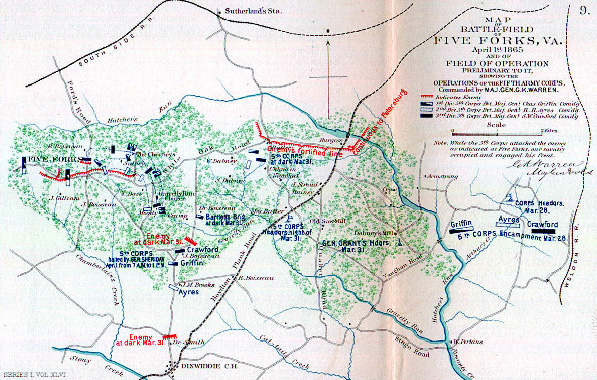
Topic I:

Overview:
The documents and exercises provided with this topic give students a
chance to examine official records, maps, photographs, and general's
orders, and to take a virtual tour of the Five Forks battlefield site.
The battle of Five Forks was part of the Appomattox campaign. It took place on April 1, 1865, just five miles north of Dinwiddie Courthouse. General Robert E. Lee was known to have ordered his troops to "Hold Five Forks at all hazards," a command that underscores the strategic importance of this location to the Confederacy. Near Five Forks was a line of the Southside Railroad, Lee's last supply route into the city of Petersburg. It was critical to the city that this rail line be protected.
The outcome of the Five Forks battle was affected by heavy rains, as well as by the configuration of roads, which resembled a starfish and presented a unique challenge to the commanding generals. Ultimately, northern troops proved victorious, and the Union army, under the command of General George Meade, smashed the Confederate line and opened the door to Petersburg.
The battle of Five Forks was later called the "Waterloo of the Confederacy" for leading to the siege of Petersburg and to the ultimate fall of Richmond. It also cost one northern general, Gen. Gouverneur Kemble Warren, his commission in the army.
Click here to visit the Five Forks National Battlefield Park
SOL OBJECTIVES: 4.4, 4.7, 5.7,5.8, 5.9, 5.10, 6.1, 11.6, 11.15, 11.17, 11.18
Levels:
Level I activities are designed for basic
knowledge and comprehension.
Students will be able to recall information and make use of the information
by identifying, quoting, listing, defining, giving examples, explaining, or
illustrating what they have learned.
Level II activities
require the student to apply and analyze the material
they have learned by doing such things an writing examples, drawing
conclusions, demonstrating what they have learned and making
predictions.
Level III activities are designed to stimulate
synthesis and evaluation.
The students will complete activities which require them to design and
create projects, make generalizations, compare and contrast, draw
conclusions, evaluate and plan.
Suggested time: one to two class periods
Materials needed: documents, glossary